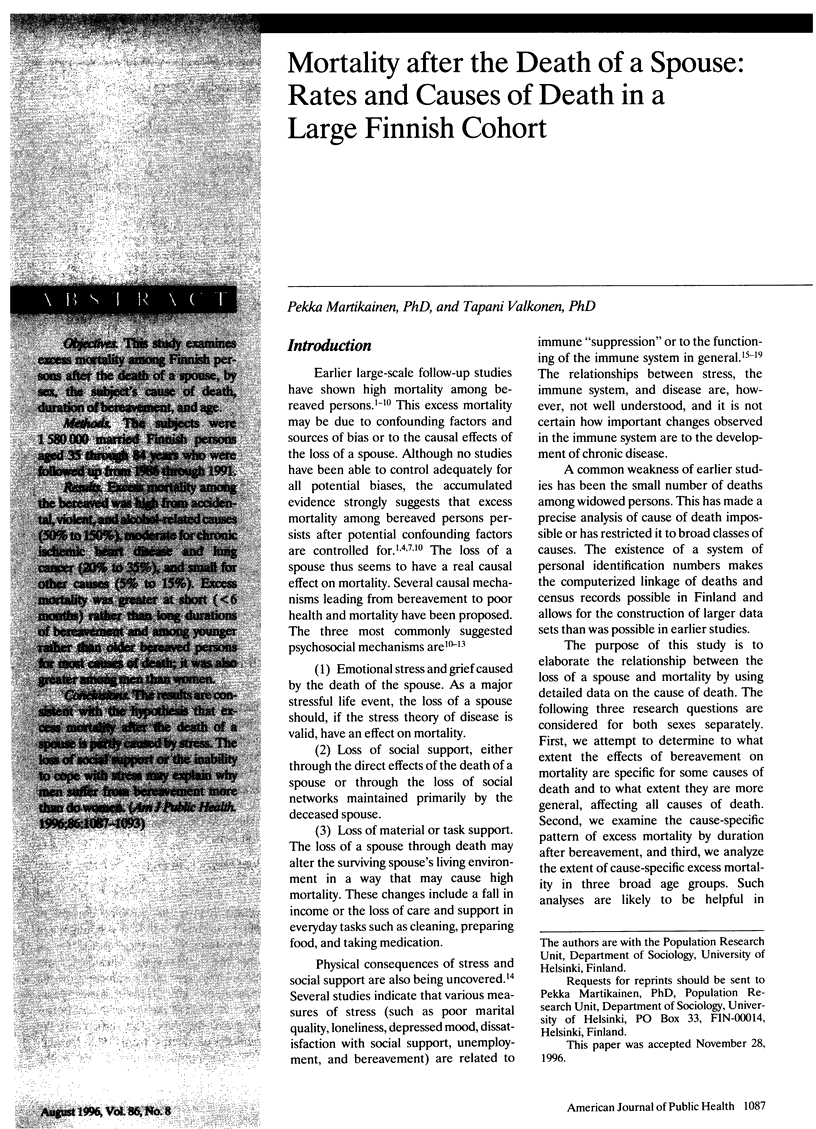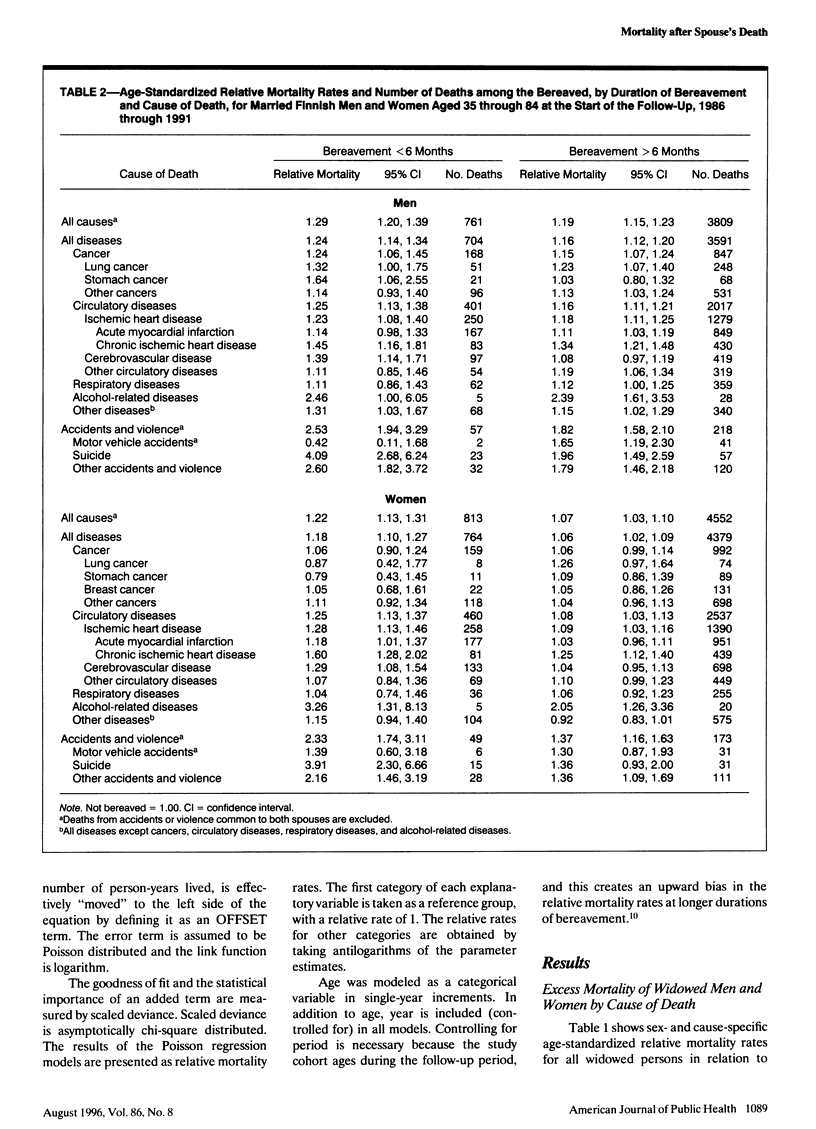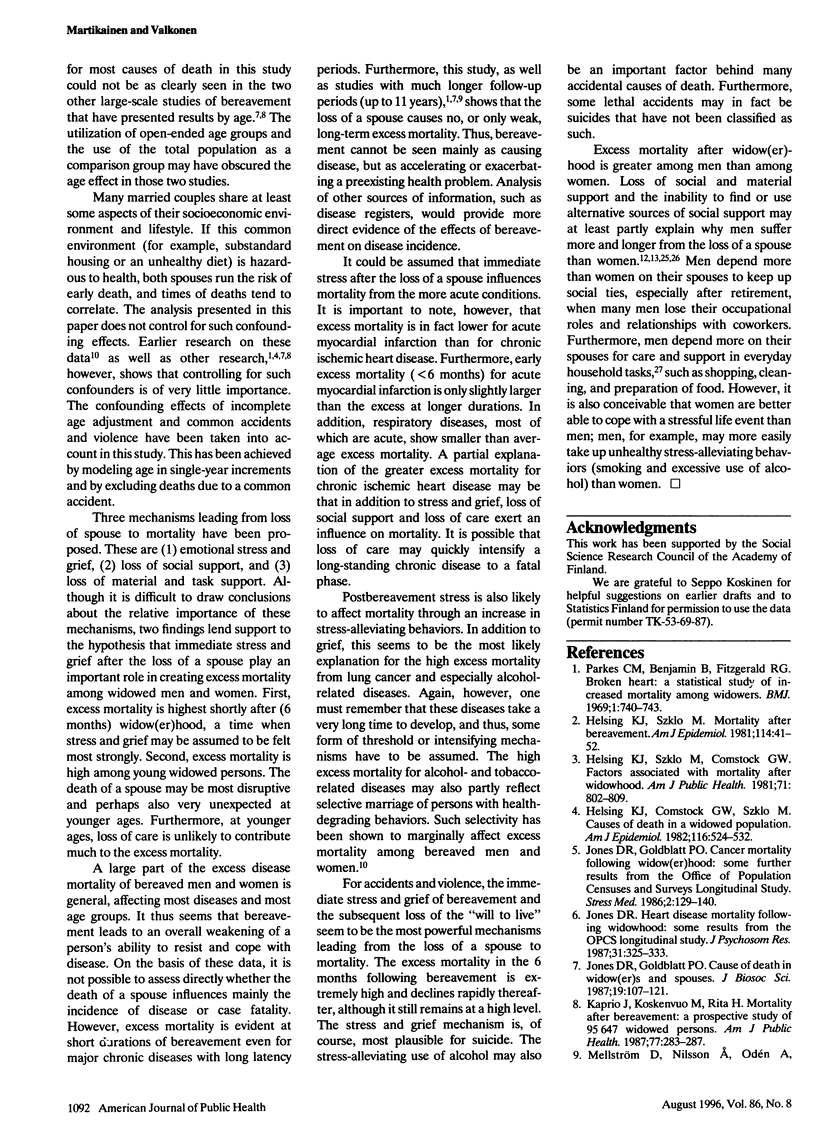Abstract
OBJECTIVES. This study examines excess mortality among Finnish persons after the death of a spouse, by sex, the subject's cause of death, duration of bereavement, and age. METHODS. The subjects were 1580000 married Finnish persons aged 35 through 84 years who were followed up from 1986 through 1991. RESULTS. Excess mortality among the bereaved was high from accidental, violent, and alcohol-related causes (50% to 150%), moderate for chronic ischemic heart disease and lung cancer (20% to 35%), and small for other causes (5% to 15%). Excess mortality was greater at short ( < 6 months) rather than long durations of bereavement and among younger rather than older bereaved persons for most causes of death; it was also greater among men that women. CONCLUSIONS. The results are consistent with the hypothesis that excess mortality after the death of a spouse is partly caused by stress. The loss of social support or the inability to cope with stress may explain why men suffer from bereavement more than do women.
Full text
PDF






Selected References
These references are in PubMed. This may not be the complete list of references from this article.
- Arnetz B. B., Wasserman J., Petrini B., Brenner S. O., Levi L., Eneroth P., Salovaara H., Hjelm R., Salovaara L., Theorell T. Immune function in unemployed women. Psychosom Med. 1987 Jan-Feb;49(1):3–12. doi: 10.1097/00006842-198701000-00001. [DOI] [PubMed] [Google Scholar]
- Bowling A. Mortality after bereavement: a review of the literature on survival periods and factors affecting survival. Soc Sci Med. 1987;24(2):117–124. doi: 10.1016/0277-9536(87)90244-9. [DOI] [PubMed] [Google Scholar]
- Helsing K. J., Comstock G. W., Szklo M. Causes of death in a widowed population. Am J Epidemiol. 1982 Sep;116(3):524–532. doi: 10.1093/oxfordjournals.aje.a113436. [DOI] [PubMed] [Google Scholar]
- Helsing K. J., Szklo M., Comstock G. W. Factors associated with mortality after widowhood. Am J Public Health. 1981 Aug;71(8):802–809. doi: 10.2105/ajph.71.8.802. [DOI] [PMC free article] [PubMed] [Google Scholar]
- Helsing K. J., Szklo M. Mortality after bereavement. Am J Epidemiol. 1981 Jul;114(1):41–52. doi: 10.1093/oxfordjournals.aje.a113172. [DOI] [PubMed] [Google Scholar]
- Irwin M., Patterson T., Smith T. L., Caldwell C., Brown S. A., Gillin J. C., Grant I. Reduction of immune function in life stress and depression. Biol Psychiatry. 1990 Jan 1;27(1):22–30. doi: 10.1016/0006-3223(90)90016-u. [DOI] [PubMed] [Google Scholar]
- Jones D. R., Goldblatt P. O. Cause of death in widow(er)s and spouses. J Biosoc Sci. 1987 Jan;19(1):107–121. doi: 10.1017/s0021932000016667. [DOI] [PubMed] [Google Scholar]
- Jones D. R. Heart disease mortality following widowhood: some results from the OPCS Longitudinal Study. Office of Population Censuses and Surveys. J Psychosom Res. 1987;31(3):325–333. doi: 10.1016/0022-3999(87)90052-3. [DOI] [PubMed] [Google Scholar]
- Kaprio J., Koskenvuo M., Rita H. Mortality after bereavement: a prospective study of 95,647 widowed persons. Am J Public Health. 1987 Mar;77(3):283–287. doi: 10.2105/ajph.77.3.283. [DOI] [PMC free article] [PubMed] [Google Scholar]
- Kiecolt-Glaser J. K., Fisher L. D., Ogrocki P., Stout J. C., Speicher C. E., Glaser R. Marital quality, marital disruption, and immune function. Psychosom Med. 1987 Jan-Feb;49(1):13–34. doi: 10.1097/00006842-198701000-00002. [DOI] [PubMed] [Google Scholar]
- Kiecolt-Glaser J. K., Kennedy S., Malkoff S., Fisher L., Speicher C. E., Glaser R. Marital discord and immunity in males. Psychosom Med. 1988 May-Jun;50(3):213–229. doi: 10.1097/00006842-198805000-00001. [DOI] [PubMed] [Google Scholar]
- Kohen J. A. Old but not alone: informal social supports among the elderly by marital status and sex. Gerontologist. 1983 Feb;23(1):57–63. doi: 10.1093/geront/23.1.57. [DOI] [PubMed] [Google Scholar]
- Mellström D., Nilsson A., Odén A., Rundgren A., Svanborg A. Mortality among the widowed in Sweden. Scand J Soc Med. 1982;10(2):33–41. doi: 10.1177/140349488201000201. [DOI] [PubMed] [Google Scholar]
- Parkes C. M., Benjamin B., Fitzgerald R. G. Broken heart: a statistical study of increased mortality among widowers. Br Med J. 1969 Mar 22;1(5646):740–743. doi: 10.1136/bmj.1.5646.740. [DOI] [PMC free article] [PubMed] [Google Scholar]
- Susser M. Widowhood: a situational life stress or a stressful life event? Am J Public Health. 1981 Aug;71(8):793–795. doi: 10.2105/ajph.71.8.793. [DOI] [PMC free article] [PubMed] [Google Scholar]
- Thomas P. D., Goodwin J. M., Goodwin J. S. Effect of social support on stress-related changes in cholesterol level, uric acid level, and immune function in an elderly sample. Am J Psychiatry. 1985 Jun;142(6):735–737. doi: 10.1176/ajp.142.6.735. [DOI] [PubMed] [Google Scholar]


